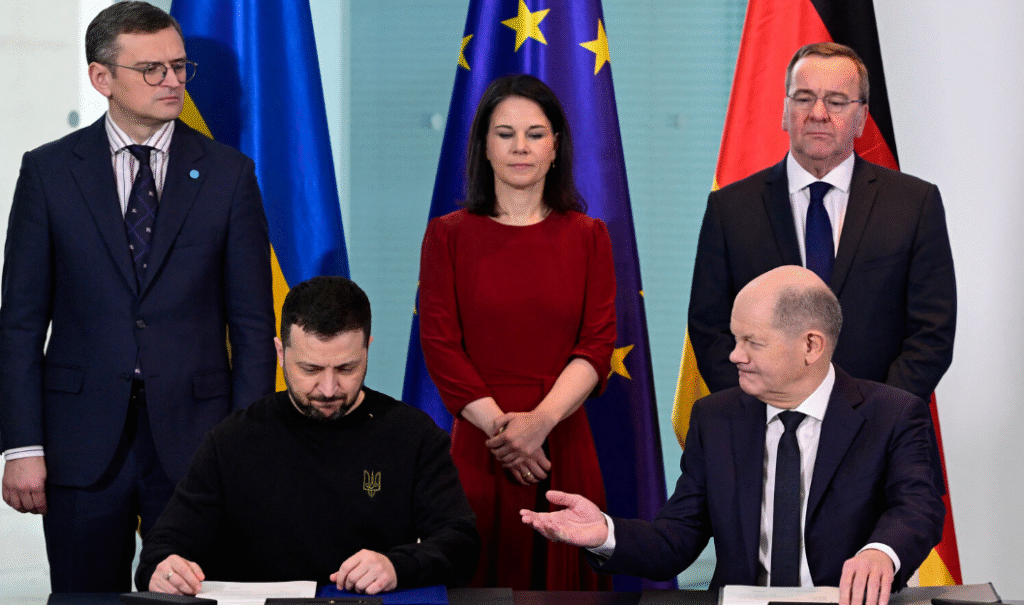Ukrainian President Volodymyr Zelensky arrived in Berlin on August 13, 2025, ahead of critical peace discussions. His visit was part of an effort to ensure that Ukraine has a strong and clear voice in upcoming negotiations with Russia. German Chancellor Friedrich Merz personally welcomed Zelensky, signaling Germany’s commitment to supporting Ukraine in international diplomacy.
European Leaders Stress Ukraine’s Central Role in Peace Talks
During his Berlin visit, Zelensky met with top European leaders, including Chancellor Merz and NATO Secretary-General Mark Rutte. The European leaders emphasized that any peace deal must include Ukraine directly and cannot allow Russia to retain occupied territories.

Zelensky echoed these concerns, insisting that Ukraine will not accept territorial concessions. European officials stressed the importance of unity, making it clear that Ukraine’s presence at the negotiation table is non-negotiable. This meeting showed the strong alignment between Ukraine and its European allies as the world watches the peace process unfold.
Virtual Summit with Global Leaders Focuses on Ceasefire
Following the in-person meetings, Zelensky joined a virtual summit with President Trump, European leaders, and U.S. Vice President Vance. Trump described the discussion as “very friendly” and called the upcoming Alaska summit a chance to better understand Putin’s intentions.

The virtual meeting focused on establishing a ceasefire and ensuring that Ukraine has a direct role in negotiations. Leaders highlighted that any peace deal must respect Ukraine’s sovereignty and security needs. This online summit reinforced the commitment of global leaders to a peaceful and fair resolution while keeping Ukraine at the center.
Zelensky Pushes for Security Guarantees and Strong Terms
Throughout his visit, Zelensky emphasized that Ukraine would not compromise on its territorial integrity. He called for binding security guarantees as a key component of any agreement. He insisted that no decisions about Ukraine should be made without Ukraine’s involvement. Zelensky’s firm stance highlights the importance of safeguarding his nation’s sovereignty.

He also encouraged the international community to support measures that protect civilians, rebuild infrastructure, and ensure stability throughout the conflict zones. The message was clear: Ukraine must be an active participant, not a bystander, in decisions about its future.
Trump Signals Willingness to Engage Both Leaders
President Trump, ahead of the Alaska summit, indicated that he is open to meetings with both Zelensky and Putin if initial discussions produce progress. He said his main goal is to push for a ceasefire and reduce ongoing violence.
European leaders welcomed Trump’s approach to include Ukraine in talks, but they also cautioned against any agreement that could compromise Ukraine’s security. The diplomatic maneuvering shows how complex and high-stakes these negotiations are, with multiple countries involved in shaping the outcome.
Zelensky’s Berlin trip is more than a series of meetings; it is a strategic effort to ensure that Ukraine is not sidelined in discussions about its future. The visit allows European leaders and the U.S. to hear Ukraine’s perspective directly and align their strategies for the upcoming Alaska summit. Analysts say that this proactive approach increases the chances of a ceasefire and a lasting diplomatic solution.


 Germany updates: Canadian and Belgian PMs visit Berlin
Germany updates: Canadian and Belgian PMs visit Berlin  Zelensky to Meet Trump in Washington Alaska ‘No Deal’ on Ukraine
Zelensky to Meet Trump in Washington Alaska ‘No Deal’ on Ukraine  Russia attacked Ukraine with 200 decoy drones
Russia attacked Ukraine with 200 decoy drones 
 Zelensky is ready to negotiate for mineral deals
Zelensky is ready to negotiate for mineral deals  Trump threatened Russia after a week of conciliatory statements
Trump threatened Russia after a week of conciliatory statements